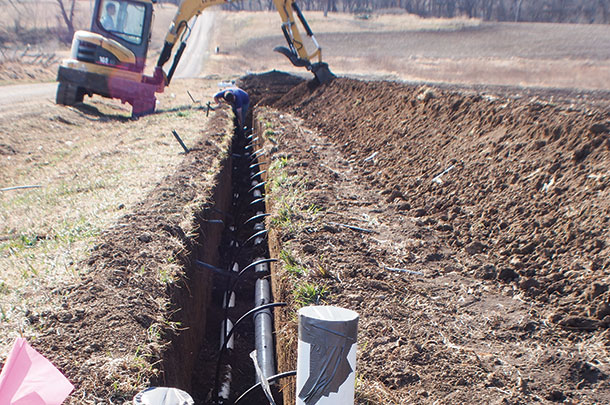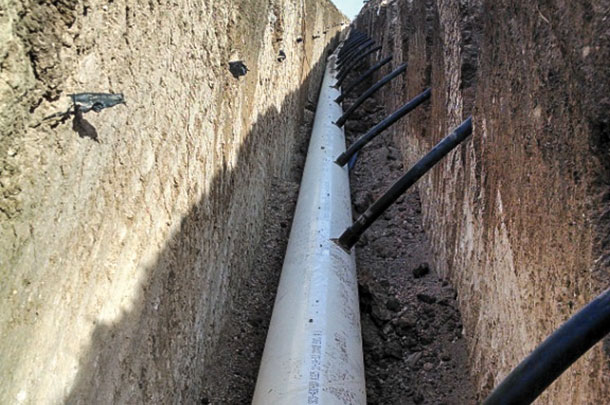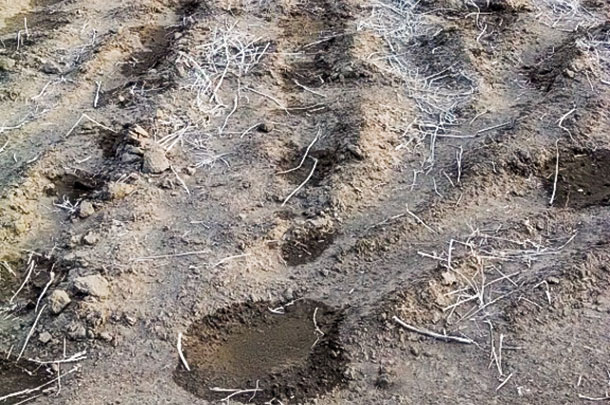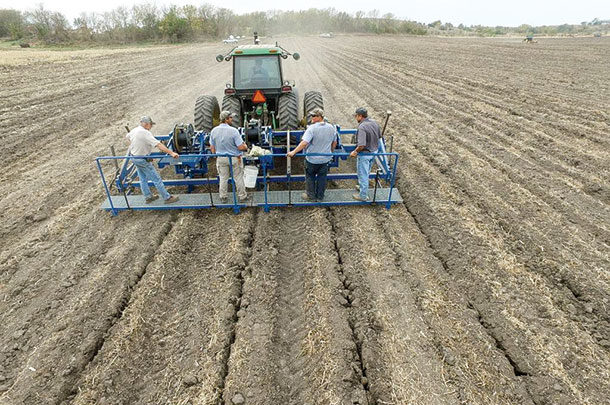2012 was a make-it-or-break-it year for a lot of growers. If they had traditional irrigation systems, likely there was at least some production. But there was one group of farmers who continued to produce and pay for their irrigation investments in 2012. They are the ones who used subsurface drip irrigation (SDI).
SDI is rapidly gaining recognition and popularity because it applies water and fertilizer directly into the root zone. SDI utilizes drip tubes (tape) that are between a half-inch and 1 inch in diameter. These drip tubes, or drip tapes, are buried just beneath the root zone, between 8 to 16 inches deep and spaced 40 to 60 inches apart, ensuring uniform watering of your crop.
PVC pipe is placed in two trenches, one at each end of the field, and the tape is connected to the PVC. One side has pressurized water, which is the supply manifold. The trench on the far end of the field simply connects all of the tape (drip tubing) together in the “flush manifold” and has a valve that discharges to the surface.

Economizing water is one of the traditional selling points of SDI. SDI saves water by placing it where the roots need it, eliminating wind and evaporation losses. It effectively helps your crop utilize almost all of the water you are applying to the field. I have been in west Texas where they were using a pivot to pre-water for cotton. It was 80ºF and a 30-mph wind was blowing.
They were short of water and losing somewhere between 20 and 50 percent to the atmosphere, which did not make for happy farmers or healthy crops. Who would like to watch their hard-earned money evaporate before their eyes? SDI cuts those losses, making sure the plant gets every drop of available water.
Is SDI beneficial on perennial forage crops? Yes, it can be a fantastic irrigation choice. In fact, with the proper recovery system, nutrient-rich effluent can be mixed with freshwater and applied to the crop, resulting in significant yield increases. In addition, pre-cutting drydown time is less than conventional irrigation, since the soil surface stays dry.
The dry soil surface on SDI fields has additional advantages. Weed pressure is decreased, and rainwater is able to soak in, allowing rainfall to be beneficially used. Some farmers have increased plant stand life on SDI fields by one to two years.
Rodents pose the biggest challenge to SDI. It is necessary to work with your SDI provider to come up with a rodent management plan. The plan will usually include some of the following: targeted extermination, biological control, repellants, pre-installation field tillage and preparing a buffer zone around the field.
A good producer will manage rodents, even without an SDI system. Unchecked rodents can reduce productivity of portions of the field 20 to 50 percent, according to Colorado State University Cooperative Extension (extension.colostate.edu/docs/pubs/natres/06515.pdf). If rodents are present, a good management plan will need to be implemented to ease rodent pressure.

SDI system installations are rapidly “moving east,” into traditional dryland, due to a whole new advantage – fertigation, or fertilizing while irrigating. How much could you boost your yield or improve your stand health if you could spoon-feed nutrients and fertilizers exactly as your crop needs it?
Imagine how our human bodies would operate if we only ate two very large meals a year compared to the right amount we need three times a day. Plants are much like us in that they thrive with the correct amount of nutrition regularly delivered. Growers know that is a formula they can bank on.
SDI systems are the most cost-effective when the drip tape is able to run a long distance. Depending on the size of tape and elevation change, tape can be run up to 2,500 feet. Early technology SDI systems were best suited for flat ground. Now, with tape innovation and computer design software, fields can be dripped that have significant elevation change and undulation.
A well-designed and installed SDI system will uniformly irrigate the crop, be simple to operate, allow the field to be worked with the least impact possible and will have a high return on investment. SDI can sound too good to be true, but there are factors which can diminish the system’s performance and return on investment. Probably the most critical factor is to find a dealer with a great amount of experience.
The dealer who sells the SDI system is the one who will most likely determine the success of your system. As a farmer, you should ask a lot of questions. SDI is not a mystery, and everything has an answer.
Here are a few questions to ask your dealer regarding your SDI design:
- What is the distribution uniformity of the system?
- What velocity does the system flush at, and how does it flush?
- What is the pressure variation in the field?
- How long has he been installing systems?
A good dealer will be working with a good designer because he knows everything hinges upon the SDI system’s design. If not designed correctly, your system will never operate right. For example, a poorly designed truck engine promises poor performance and maintenance headaches. But a good dealer will make sure you receive a system that evenly irrigates your entire field.
Distribution uniformity is a measure of how evenly the system spreads water across the field. On average, a good design has a minimum distribution uniformity of 0.92, or 92 percent; 100 percent distribution uniformity means that every part of the field is getting the exact same amount of water.
This is impossible with any irrigation system due to manufacturing variations and pressure variations. A 92 percent distribution uniformity target strikes a good balance between system economics and long-term system operation.
As farmers in areas not previously irrigated recognize the benefits of SDI, new dealers are popping up in response to these needs. For a new dealer to install a great SDI system, there are some things you should look for. Who has the SDI experience the dealer is relying on as he gains experience?
Manufacturers have a vested interest in successful installments, so is the manufacturer involved with your project? Are they hiring an experienced designer for the whole project? Remember, the design is the foundation; good design equals good foundation, bad design equals bad foundation. Do they have someone helping with the installment who has experience and a good reputation? Do they offer a service package?
In recent years, SDI product manufacturers have started taking steps to greatly reduce the cost of their systems. Now is an excellent time to find an SDI talent source and discuss your potential project with them.
Your investment into SDI is long term. If the system is successful and maintained properly, it should last at least 20 years.
Most farmers I talk with are always interested in expanding their operations. If you can boost your yields with the same inputs, would that motivate you to investigate SDI? What if you increased the productivity of your current forage crop by 25 percent? Get ready for the next drought. We don’t know when it will be here, but we do know it is coming. ![]()
PHOTO 1: Drip tape is buried 8 to 16 inches deep to deliver water and fertilizer to the plant root zone.
PHOTO 2: Drip tape is attached to a PVC feeder line at the top of the field. The drip tape is buried just beneath the root zone.
PHOTO 3: PVC pipe is also attached to drip tape at the end of the field and provides a flush manifold that discharges to the surface.
PHOTO 4: By watering from the root zone instead of from the surface, subsurface drip irrigation eliminates water loss by wind or evaporation and provides uniform moisture. Photos by Kurt Grimm – NutraDrip Irrigation Systems.

-
John Maxwell
- Independent Irrigation Designer
- Maxwell Irrigation
- Email John Maxwell












